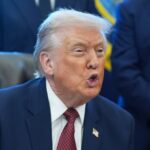

This is the last calendar year of President Joe Biden‘s presidency, a term that saw an increase of electric vehicles in its own federal fleet. The administration issued a fact sheet in December applauding the increase of 82,000 electric and hybrid vehicles from the 2,000 under then-President Donald Trump. However, the administration’s attempt to replicate this switch to electric vehicles nationwide has raised concerns among those in the industry.
At the beginning of the year, Ford Motor Company estimated that EVs would require 40% less labor to manufacture. According to the United Automobile Workers President Shawn Fain, the union is confident it will protect its members from losing jobs to the electric movement.
“The UAW has been at the front of environmental and working-class issues. The biggest thing to us, no matter which way we go in this, we’re going to have security for our members and for the working class people,” Fain said in January. “We’re not afraid of where we’re headed.”
In April, Ford lost $1.3 billion in its EV department during the first quarter of 2024, which is about $132,000 per vehicle it sold. The loss was due to the car maker lowering the price of its electric models while also appropriating funds for further research. Electric vehicle revenue brought in $100 million, which is an 84% drop from last year. Ford president and CEO Jim Farley assured stockholders that Ford is pursuing greater value for all its vehicles.
“Customers want vehicles that they’re passionate about, choices in how they’re powered, quality
that’s constantly getting better and great value,“ Farley said in a statement released with Ford’s Q3 financials.
J.D. Power Executive Director of EV Intelligence Stewart Stropp issued a statement in May when his company released its most recent study of EV consideration, reporting the first time interest dropped since the study’s inception in 2021. According to its survey of over 8,000 respondents, 24% reported they were “very likely” considering going electric, which was down 2% from last year.
“As the industry inches toward mass consumer adoption, the main roadblocks to getting consumers behind the wheel of an EV are the continued shortage of affordable vehicles, charging concerns, and a lack of knowledge regarding the EV ownership proposition, including incentives,” Stropp said. “As understanding of EV incentives rises, so does the likelihood of consideration. However, approximately 40% of shoppers say they do not have a solid understanding of such incentives.”
Toyota Motor Corporation Chairman Akio Toyoda claimed that a U.S. electric vehicle mandate would hurt jobs in the United States and Japan.
“There are 5.5 million people involved in the automotive industry in Japan,” Toyoda told reporters in October. “Among them are those who have been doing engine-related [work] for a long time. If electric vehicles simply become the only choice, including for our suppliers, those people’s jobs would be lost.”
The U.S. Department of Transportation is struggling to provide chargers while promoting electric vehicles under the Biden administration’s promises. By May, the administration had only built about eight charging stations over two years with $7.5 billion on hand. Its goal is to have 500,000 new chargers by 2030.
In December, the Biden administration reported installing 10,500 charging ports on federal facilities, and there were 52,500 charging ports in progress across the country.
The U.S. Postal Service purchased 9,250 E-Transit vans from Ford through the end of 2024 in its switch to electric. This comes as the Biden administration pursued a 2030 mandate of 50% EVs on top of a 2032 mandate of 67%.
President-elect Donald Trump has alluded to an EV mandate as a “bloodbath” for the industry. Trump was in Dayton, Ohio, in March when he was disparaging electric vehicles and made campaign promises to maintain the auto industry there. The 2024 candidate blasted China for its part in building car factories in Mexico for the cause and threatened tariffs.
CLICK HERE TO READ MORE FROM THE WASHINGTON EXAMINER
By November, Trump’s attitude softened while traveling to and from a SpaceX launch, which included a Tesla Cybertruck in the motorcade lineup. The motorcade featured a mix of the typical black Chevy sports utility vehicles and Ford trucks, plus the lone electric vehicle. Presidents have long traveled via motorcade but typically use uniform vehicles for the president’s safety. This inclusion of a Cybertruck was a nod to SpaceX and Tesla CEO Elon Musk, who welcomed Trump to the launch site.
Meanwhile, from January through the end of October this year, Americans bought 1,269,949 plug-in hybrids and battery-electric vehicles. Consumers are on track to beat last year’s sales of 1.4M plug-in electric vehicles, which at the time was an increase of over 50% from 2022.





